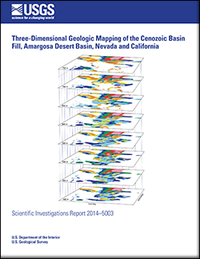Understanding the subsurface geologic framework of the Cenozoic basin fill that underlies the Amargosa Desert in southern Nevada and southeastern California has been improved by using borehole data to construct three-dimensional lithologic and interpreted facies models. Lithologic data from 210 boreholes from a 20-kilometer (km) by 90-km area were reduced to a limited suite of descriptors based on geologic knowledge of the basin and distributed in three-dimensional space using interpolation methods. The resulting lithologic model of the Amargosa Desert basin portrays a complex system of interfingered coarse- to fine-grained alluvium, playa and palustrine deposits, eolian sands, and interbedded volcanic units. Lithologic units could not be represented in the model as a stacked stratigraphic sequence due to the complex interfingering of lithologic units and the absence of available time-stratigraphic markers. Instead, lithologic units were grouped into interpreted genetic classes, such as playa or alluvial fan, to create a three-dimensional model of the interpreted facies data. Three-dimensional facies models computed from these data portray the alluvial infilling of a tectonically formed basin with intermittent internal drainage and localized regional groundwater discharge. The lithologic and interpreted facies models compare favorably to resistivity, aeromagnetic, and geologic map data, lending confidence to the interpretation.


